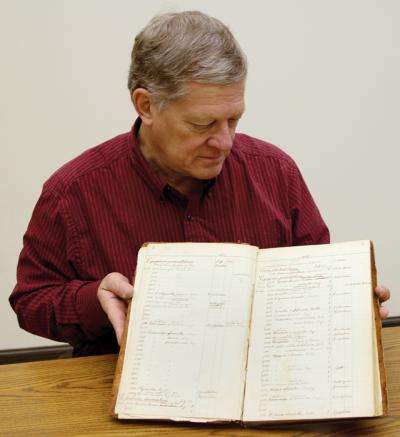John Marlin, Illinois Sustainable Technology Center, is a research affiliate with the Illinois Natural History Survey. He displays one of Charles Robertson's original accession books in which he recorded data about over 25,000 insects he collected in Carlinville, Illinois. Credit: Michael Knapp
A study published in the journal Science reveals a decline in bee species since the late 1800s in West Central Illinois. The study could not have been conducted without the work of a 19th-century naturalist, says a co-author of the new research.
Charles Robertson, a self-taught entomologist who studied zoology and botany at Harvard University and the University of Illinois, was one of the first scientists to make detailed records of the interactions of wild bees and the plants they pollinate, says John Marlin, a co-author of the new analysis in Science. In the 1970s, Marlin, a research affiliate with the Illinois Sustainable Technology Center and Illinois Natural History Survey at the U. of I., used Robertson's records as a basis for his own research on the wild bees around Carlinville, Ill., an area rich in woodlands and native prairie.
Marlin's research was documented in a 2001 Ecology and Society article ("The Native Bee Fauna of Carlinville, Illinois, Revisited After 75 Years: a Case for Persistence"). That study focused on the 24 plant species that Robertson had found harbored the most bee species. Seventy-five years after Robertson's research, Marlin found 82 percent of the species Robertson had collected in the original study.
The new article in Science, by Laura Burkle, of Montana State University, Marlin and Tiffany Knight, of Washington University, shows a considerable decline in the number of bee species in the Carlinville area since both the Robertson and Marlin studies. On spring woodland wildflowers they found only half of the bee species that Robertson originally documented.
"This is an indication that something dramatic has happened to the landscape," Marlin said.
"Carlinville is one of the most referenced communities in the world in the bee literature," Marlin said. "It is clear that Charles Robertson's foundation provides an invaluable resource for modern comparative studies on bee species and their interactions with the environment."
The center and survey are part of the Prairie Research Institute at Illinois.
More information: The paper, "Plant-pollinator interactions over 120 years: loss of species, co-occurrence and function," is available online at www.sciencemag.org/content/ear … nce.1232728.full.pdf
Journal information: Science
Provided by University of Illinois at Urbana-Champaign





















